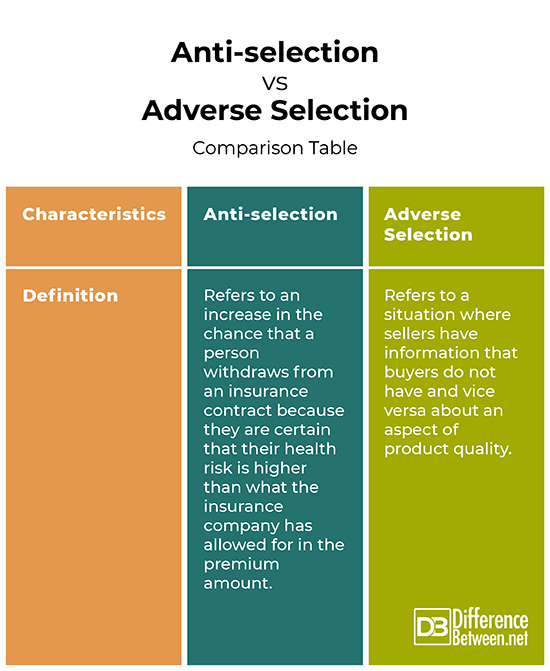Difference Between Anti-Selection and Adverse Selection
With increasing risks and uncertainties in life, the need for insurance cover has increased over time, with people insuring their health, businesses, animals, and even their own lives! Now, all of us know you need a third eye when buying these covers to ensure you understand clearly what it is you are signing up for to avoid being downplayed. That said, two terms are very common and nearly impossible to separate when you mention insurance, namely Anti-selection, and Adverse selection. They are so similar; most people think they are the same. The truth is they are different. But what exactly are their differences? Let’s find out in this article.

What is Anti-Selection?
Anti-selection refers to an increase in the chance that a person withdraws from an insurance contract because they are certain that their health risk is higher than what the insurance company has allowed for in the premium amount. In short, the insurance company has offered them less premium compared to the magnitude of their health concerns. The person realizes that in the event of these outcomes, he will not benefit much and opts out. An example is when a person has an underlying condition and the premium is way less than it would take to cater for the condition. Since the sick are more likely to sign up for the cover, the company must increase rates to cater to the claims. This in turn pushes healthier people away.

What is Adverse Selection?
Adverse Selection refers to a situation where sellers have information that buyers do not have and vice versa about an aspect of product quality. In this case, asymmetric information, also known as information failure, is put into use. This refers to a scenario where one party has greater knowledge about a subject than the other party. The more knowledgeable party is certainly the seller.
Asymmetric information leads to bad decisions for the party that is less knowledgeable such as engaging more in less profitable and riskier markets.
In insurance, adverse selection applies in instances where people in high-risk or dangerous jobs purchase products like life insurance. Here the buyer has more information about their health and they can use this to their advantage by holding some things back. An example is a smoker who manages to get the same cover as a non-smoker by concealing the fact that he smokes. In practice, a smoker attracts more premiums to get the same cover as a non-smoker as smoking is considered high risk for life and health insurance. This leads the company to make bad decisions about managing financial risks and attracts losses in the long run.
A seller may also have more information than a buyer whose failure to disclose can be disadvantageous to the buyer. An example is when an insurance company sells premiums at a higher rate than is expected depending on what they are offering to unsuspecting customers. The buyer ends up buying at a higher price than is expected of them to their disadvantage.
Another common example of adverse selection in the automobile industry is when a seller of a second-hand vehicle assures the buyer that the vehicle he’s selling is intact and in good shape. He manages to sell it at a higher rate than he ought to yet he knows it has a problem. This poses a risk of financial loss and dissatisfaction for the buyer who has been ‘cheated’.
Insurance companies fight adverse selection by reducing exposure to large claims by limiting coverage or raising premiums. A company, for example, identifies people more at risk than the general population and charges them more.
Similarities between anti-selection and adverse selection
- They are both insurance terms.
- They both use asymmetric information where one party has information that the other party doesn’t.
Differences between anti-selection and Adverse Selection
Definition
Anti-selection refers to an increase in the chance that a person withdraws from an insurance contract because they are certain that their health risk is higher than what the insurance company has allowed for in the premium amount.
Adverse Selection refers to a situation where sellers have information that buyers do not have and vice versa about an aspect of product quality.
Anti-selection vs. Adverse Selection: Comparison Table

Anti-selection vs. Adverse Selection: Conclusion
Whether you are buying a premium now or in the future, knowing the difference between the two terms puts you in a position to make a better decision. Anti-selection refers to an increase in the chance that a person withdraws from an insurance contract because they are certain that their health risk is higher than what the insurance company has allowed for in the premium amount.
Adverse selection refers to a situation where sellers have information that buyers do not have and vice versa about an aspect of product quality.
FAQs
What is an example of adverse selection?
Someone with a nicotine dependency gets insurance at the same rate as someone without nicotine dependency
What is adverse risk selection?
Adverse Selection refers to a situation where sellers have information that buyers do not have and vice versa about an aspect of product quality.
Which would be an example of an adverse selection problem?
An example is a smoker who manages to get the same cover as a non-smoker by concealing the fact that he smokes.
Why is it called adverse selection?
Because the risk given to the client is substantially higher than that known to the insurer company, and therefore it poses financial risks to the company and vice versa.
- Difference Between Profit Center and Investment Center - July 2, 2022
- Difference Between Anti-Trust and Anti-Competition - June 6, 2022
- Difference Between Stocktaking and Stock Control - June 6, 2022
Search DifferenceBetween.net :
Leave a Response
References :
[0]Guy Thomas. Loss Coverage: Why Insurance Works Better with Some Adverse Selection. Cambridge University Press, 2017. https://books.google.co.ke/books?id=CXOuDgAAQBAJ&printsec=frontcover&dq=Difference+between+Anti-selection+and+Adverse+Selection&hl=en&sa=X&ved=2ahUKEwjT7aufj7f3AhUn7rsIHZU2A2wQ6AF6BAgFEAI#v=onepage&q=Difference%20between%20Anti-selection%20and%20Adverse%20Selection&f=false
[1]Shaw R & Escobar M. The Impact of Health Insurance in Low- and Middle-Income Countries. Brookings Institution Press, 2011. https://books.google.co.ke/books?id=5YjPssKCHQYC&printsec=frontcover&dq=Difference+between+Anti-selection+and+Adverse+Selection&hl=en&sa=X&ved=2ahUKEwjM642uj7f3AhVb_rsIHTq4D_o4ChDoAXoECAsQAg#v=onepage&q&f=false
[2]Amy Finkelstein. Moral Hazard in Health Insurance. Columbia University Press, 2014. https://books.google.co.ke/books?id=ZzkjBQAAQBAJ&printsec=frontcover&dq=Difference+between+Anti-selection+and+Adverse+Selection&hl=en&sa=X&ved=2ahUKEwjy1v2-j7f3AhX7_rsIHbzwCREQ6AF6BAgKEAI#v=onepage&q&f=false
